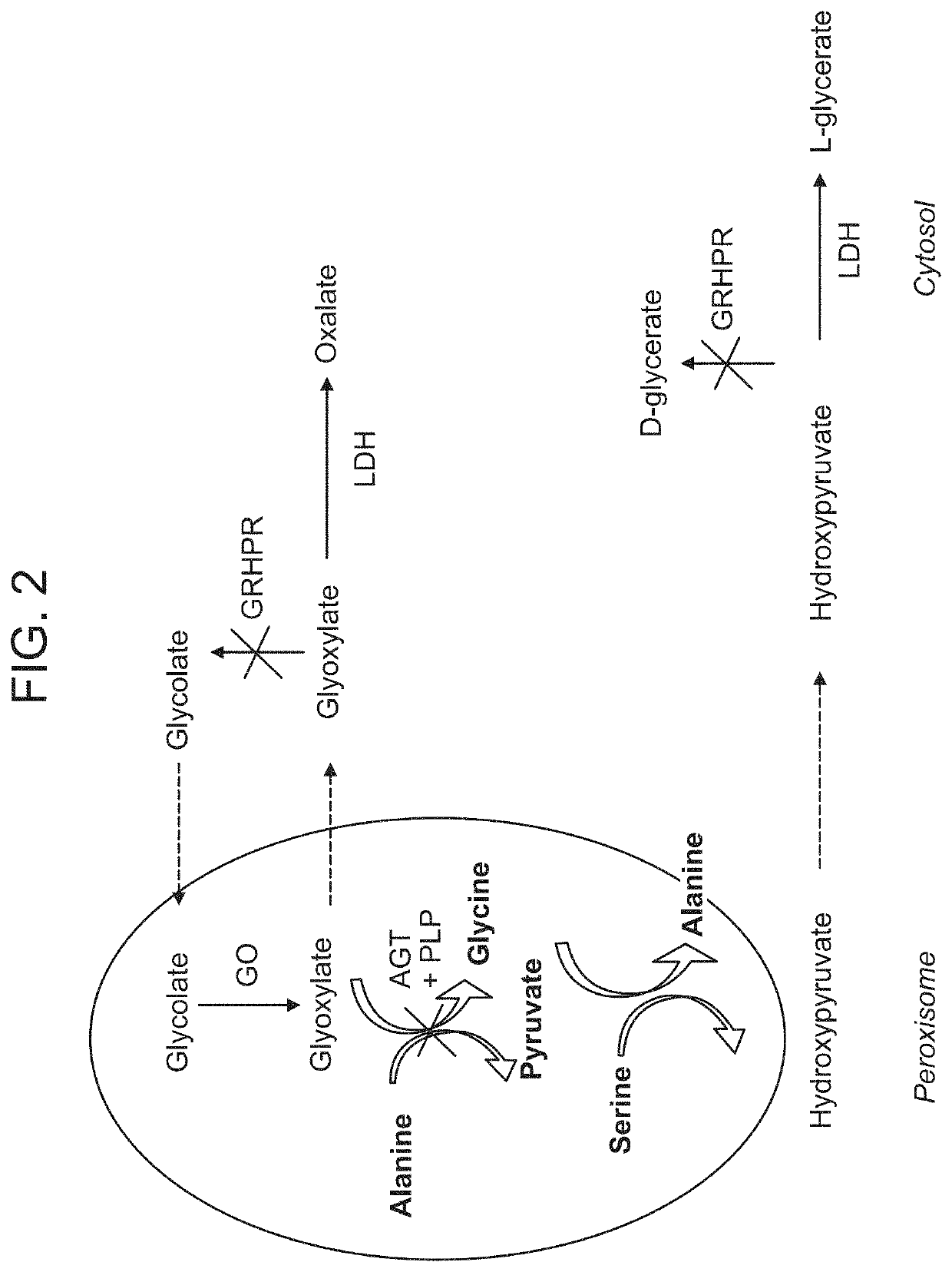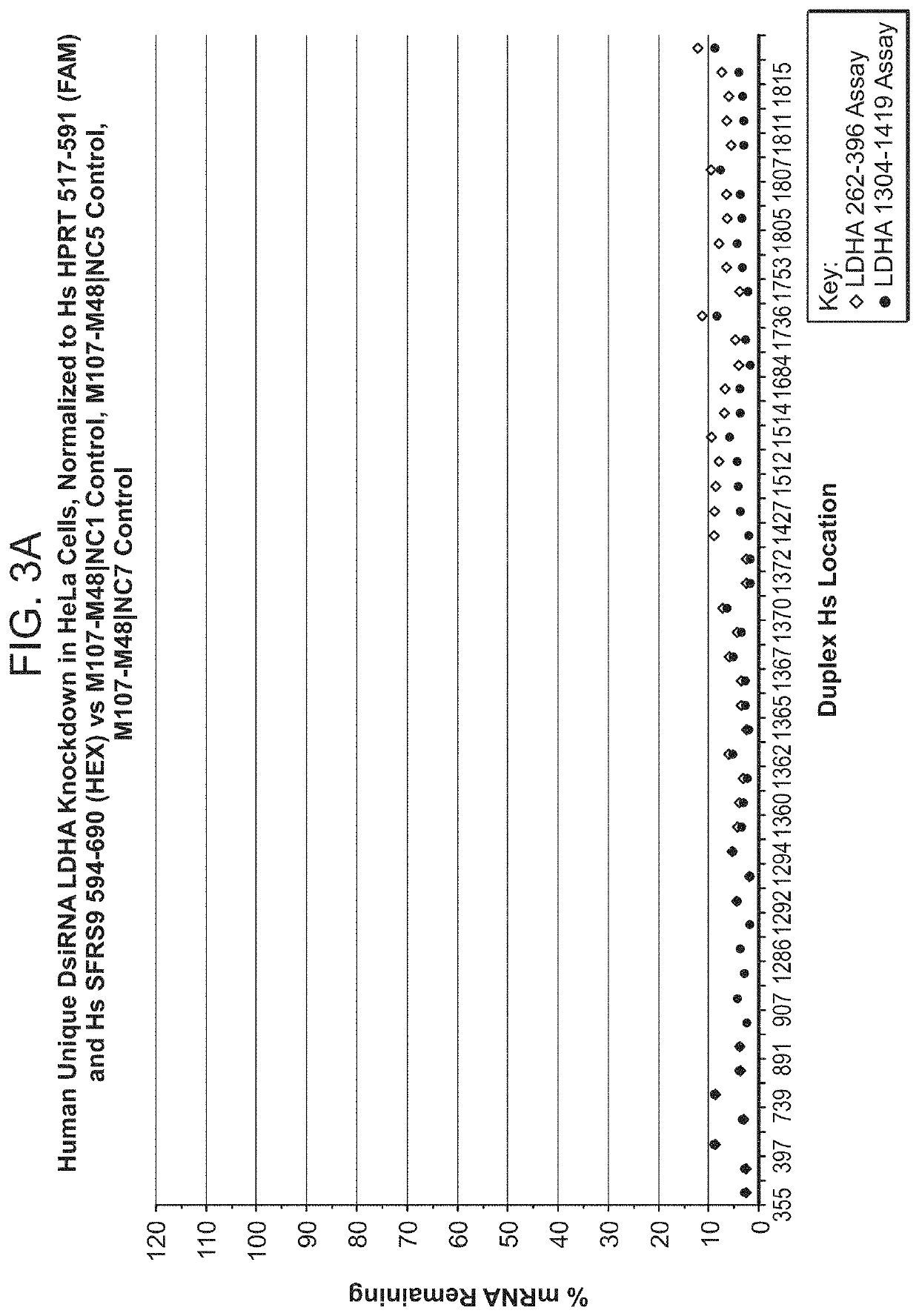Therapeutic inhibition of lactate dehydrogenase and agents therefor
a technology of lactate dehydrogenase and inhibitors, which is applied in the direction of drug compositions, extracellular fluid disorders, muscular disorders, etc., can solve the problems that inhibition of ldha using small molecule inhibitors cannot be readily targeted to specific organs without, and the effect of elevating lactose levels and robust levels of lactate dehydrogenase knockdown
- Summary
- Abstract
- Description
- Claims
- Application Information
AI Technical Summary
Benefits of technology
Problems solved by technology
Method used
Image
Examples
example 1
Preparation of Double-Stranded RNA Oligonucleotides
[1071]Oligonucleotide Synthesis and Purification
[1072]DsiRNA molecules can be designed to interact with various sites in the RNA message, for example, target sequences within the RNA sequences described herein. In presently exemplified agents, 48 DsiRNAs predicted on the basis of homology to uniquely target human lactate dehydrogenase (LDHA) sequences, 48 DsiRNAs predicted on the basis of homology to uniquely target mouse lactate dehydrogenase sequences, and an additional 24 DsiRNAs predicted to target both human and mouse lactate dehydrogenase sequences were selected for evaluation. The sequences of one strand of the DsiRNA molecules were complementary to target lactate dehydrogenase site sequences. The DsiRNA molecules were chemically synthesized using methods described herein. Generally, DsiRNA constructs were synthesized using solid phase oligonucleotide synthesis methods as described for 19-23mer siRNAs (see for example Usman e...
example 2
DsiRNA Inhibition of LDHA
[1085]DsiRNA molecules targeting LDHA were designed and synthesized as described above and tested in human HeLa cells (alternatively, HepG2 or other human cells could have been used) and / or mouse B16-F10 cells for inhibitory efficacy. For transfection, annealed DsiRNAs were mixed with the transfection reagent (Lipofectamine™ RNAiMAX, Invitrogen) and incubated for 20 minutes at room temperature. The HeLa (human) or B16-F10 (mouse) cells (alternatively, mouse Hepa 1-6 or other mouse cells could have been used) were trypsinized, resuspended in media, and added to wells (100 uL per well) to give a final DsiRNA concentration of 1 nM in a volume of 150 μl. Each DsiRNA transfection mixture was added to 3 wells for triplicate DsiRNA treatments. Cells were incubated at 37° C. for 24 hours in the continued presence of the DsiRNA transfection mixture. At 24 hours, RNA was prepared from each well of treated cells. The supernatants with the transfection mixtures were fir...
example 3
Lactate Dehydrogenase-Targeting DsiRNAs were Effective Inhibitors of Both LDHA mRNA and Protein In Vivo
[1087]The efficacy of LDHA-targeting DsiRNAs to inhibit both LDHA mRNA and protein levels was examined in mice. As shown in FIGS. 4A to 4C, LDHA-targeting DsiRNAs potently inhibited mRNA and protein expression in mouse liver (human-mouse cross-reactive DsiRNAs LDHA-402, LDHA-723 and LDHA-370 possessing M107 / M48 modifications were tested for mRNA knockdown, while LDHA-402 protein levels are shown in the right panel of FIG. 4A, relative to a GAPDH control). Specifically, robust knockdown of LDHA mRNA levels was observed at 24 hours post-DsiRNA injection. Meanwhile dramatically reduced levels of LDHA protein were observed in mice administered LDHA-402 DsiRNA, even at 14 days post-i.v. injection at 1 mg / kg.
PUM
| Property | Measurement | Unit |
|---|---|---|
| length | aaaaa | aaaaa |
Abstract
Description
Claims
Application Information
 Login to View More
Login to View More - R&D
- Intellectual Property
- Life Sciences
- Materials
- Tech Scout
- Unparalleled Data Quality
- Higher Quality Content
- 60% Fewer Hallucinations
Browse by: Latest US Patents, China's latest patents, Technical Efficacy Thesaurus, Application Domain, Technology Topic, Popular Technical Reports.
© 2025 PatSnap. All rights reserved.Legal|Privacy policy|Modern Slavery Act Transparency Statement|Sitemap|About US| Contact US: help@patsnap.com



